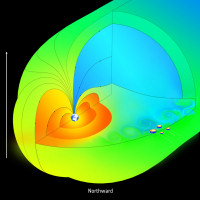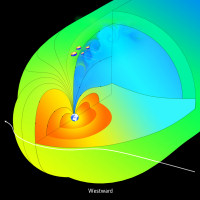Cluster observes a 'porous' magnetopause
24 October 2012
A new study based on data from ESA's Cluster mission shows that it is easier for the solar wind to penetrate Earth's magnetosphere than had previously been thought.
 |
|
Solar wind entry at low latitudes. Credit: ESA/AOES Medialab |
The recently published paper in the Journal of Geophysical Research shows that the magnetopause - the outer region of the magnetic 'shield' around our planet - is breached in numerous places by the incoming charged particles of the solar wind. As a result, the boundary of Earth's magnetic bubble behaves more like a sieve than a continuous barrier that rebuffs the persistent onslaught of electrons and protons in the solar wind.
Understanding how the interaction of the solar wind with Earth's magnetic field transfers plasma (electrified gas), momentum, and energy across the magnetopause is one of the most important questions in magnetospheric physics.
This latest discovery was made possible by the unique configuration of the four identical Cluster spacecraft, which fly in close formation through near-Earth space. As they sweep from the magnetosphere into interplanetary space — where the solar wind dominates — and back again, the flotilla provides unique three-dimensional insights on the processes associated with the Sun-Earth connection.
Previous discoveries derived from Cluster measurements have shown that the magnetopause is weakened by Kelvin-Helmholtz waves (KHW). These are huge swirls of plasma, up to 40 000 km across, which develop along the outer edge of the magnetosphere. Kelvin-Helmholtz instabilities can occur when two adjacent flows are travelling with different speeds, so one is slipping past the other. The same phenomenon also occurs in the atmosphere when two air layers lying close to each other move at different speed.
Whether or not such waves can be excited somewhere along the magnetopause depends on the direction of the interplanetary magnetic field associated with the solar wind. Instability is facilitated when the flow is moving perpendicular to the magnetic field.
One consequence of the presence of KHW is that they result in a sudden, dramatic reconfiguration of the magnetic field lines – known as magnetic reconnection. This process of breaking and reconnecting field lines enables charged particles from the solar wind to enter the magnetosphere.
As mentioned above, one key factor in the magnetosphere/solar wind interaction is the magnetic alignment of the interplanetary magnetic fields (IMF). It is generally thought that the most important process by which the solar wind enters Earth's magnetosphere is reconnection on Earth's dayside. This is most efficient when the IMF is aligned southward - the opposite to the northward alignment of Earth's magnetic field. The temporary tangling of the field lines creates ideal conditions for magnetic reconnection, allowing large amounts of plasma and magnetic energy to be transferred from the solar wind to the magnetosphere.
Magnetic reconnection also occurs with a northward orientation of the IMF, but it is more localised to higher latitudes. Spacecraft observations have indicated that Kelvin-Helmholtz waves may also play an important role in the transfer of solar wind material into the magnetosphere during a northward IMF.
A team of US scientists has now used Cluster data to show that KHW can form at high-latitudes, on the dawn/dusk flanks of the magnetopause, under other orientations of the IMF. The data were obtained between 12:00 and 17:00 UT on 12 January 2003, when the four Cluster spacecraft were in tetrahedral formation, about 4000 km apart, and flying close to the northern duskward cusp region of Earth's magnetosphere. The quartet was outbound, heading toward the evening side magnetopause.
 |
|
Solar wind entry at high latitudes. Credit: ESA/AOES Medialab |
Whilst the magnitude of the magnetic field components generally declined until about 15:10 UT, the data were also punctuated by repeated short, but well defined, drops in the magnetic field. During those intervals, the data indicated the presence of more low-energy particles, as well as high density and low temperature. These conditions were typical of the outer region of the magnetopause.
After each encounter with this outer part of this boundary layer, Cluster returned to a region of the magnetosphere which was characterised by low density and high temperature and populated largely with higher energy particles. This pattern of change represented rapid compression and expansion of the dayside magnetosphere, associated with dynamic pressure variations in the solar wind and the passage of a discontinuity in the IMF. The spacecraft then remained in the magnetosphere before re-encountering the magnetopause at 16:23 UT.
The fluctuations mostly propagated tailward, passing along the magnetopause. However, by comparing the boundary conditions before and after the passage of the IMF discontinuity, the team found that the KH instabilities were more frequent after the discontinuity passed by. Their conclusions were supported by computer simulations of the conditions along the Cluster trajectory, which showed the expansion of the magnetosphere after the discontinuity passed.
"This was the first time that the presence of KHW at the magnetopause had been demonstrated at high latitude for a dawnward orientation of the IMF," said Kyoung-Joo Hwang, a research scientist at the University of Maryland Baltimore County and NASA's Goddard Space Flight Center in Maryland, and lead author of the paper in the Journal of Geophysical Research.
The data showed that differences in IMF orientation greatly influenced the Kelvin-Helmholtz waves at the high latitude magnetopause as a result of variations in the thickness of the boundary layer and/or the width of the KH-unstable band on the surface of the dayside magnetopause.
"Although this represents only a single observation, similar IMF conditions are frequently observed at the magnetopause in the northern hemisphere," said Melvyn Goldstein from NASA's Goddard Space Flight Center, a co-author of the paper. "Since this geometry is so common, the process we describe can act as a continuous mechanism of solar wind transport into the magnetosphere."
Dr. Hwang is now undertaking a statistical study to determine how ubiquitous the KHW are and how they evolve and develop.
"This discovery shows how Earth's magnetosphere can be penetrated by solar particles under certain interplanetary magnetic field conditions," said Matt Taylor, ESA project scientist for Cluster. "The study of the high-latitude, dayside magnetopause would not have been possible without the in situ measurements sent back by Cluster. The relatively small spatial separation of the four spacecraft made it possible to analyse the spatial structures and characteristics of KHW."
These results are also relevant to studies of magnetospheric processes around other planets in the Solar System. For example, KHW and KH instabilities are commonly observed at the boundary of Mercury's magnetosphere and on the dawnward flank of Saturn's magnetopause. This new study opens up the possible locations where KHW may be generated, suggesting that they can be a common, and possibly continuous, mechanism for the entry of solar wind into planetary magnetospheres under various IMF orientations.
Notes for editors
Cluster is a constellation of four spacecraft flying in formation around Earth. It is the first space mission able to study, in three dimensions, the natural physical processes occurring within and in the near vicinity of the Earth's magnetosphere. Launched in 2000, it is composed of four identical spacecraft orbiting the Earth in a pyramidal configuration, along a nominal polar orbit of 4 × 19.6 Earth radii (1 Earth radius = 6380 km). Cluster's payload consists of state-of-the-art plasma instrumentation to measure electric and magnetic fields over wide frequency ranges, and key physical parameters characterising electrons and ions from energies of near 0 eV to a few MeV. The science operations are coordinated by the Joint Science Operations Centre (JSOC) at the Rutherford Appleton Laboratory, United Kingdom, and implemented by ESA's European Space Operations Centre (ESOC), in Darmstadt, Germany.
Contacts
Kyoung-Joo Hwang
Heliospheric Physics Laboratory
Goddard Space Flight Center, Greenbelt, Maryland, USA
Email: kyoung-joo.hwang![]() nasa.gov
nasa.gov
Melvyn L. Goldstein
Heliospheric Physics Laboratory
Goddard Space Flight Center, Greenbelt, Maryland, USA
Phone: +1-301-286-7828
Email: melvyn.l.goldstein![]() nasa.gov
nasa.gov
Matt Taylor
Cluster Project Scientist
Research and Scientific Support Department
Directorate of Science & Robotic Exploration
ESA, The Netherlands
Phone: +31-71-565-8009
Email: mtaylor![]() rssd.esa.int
rssd.esa.int

